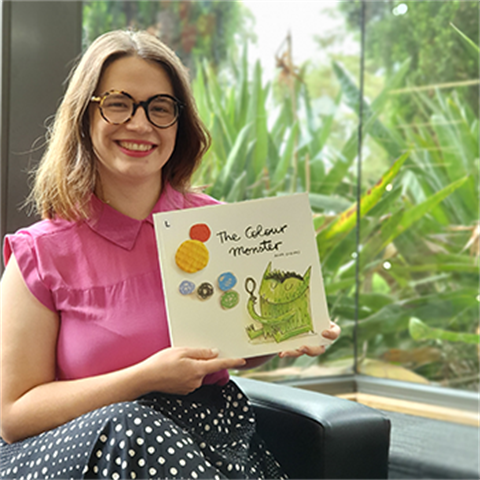EMILY: Big Feelings

No matter the age, all people experience big feelings, but hopefully as children grow to be teens and then adults, big feelings change from being unwieldy whirlwinds of emotion, to manageable feelings that can be processed in a useful or constructive way.
Story books shared at home, early education settings, or library storytimes, can be very useful to help children understand and define their feelings, as well as learn ways to identify them as they happen and adopt techniques to manage them, that suit their unique selves.
These books are also useful tools for parents, carers and educators who are usually well positioned to support a child’s early emotional development in a kind and nurturing way.
Emily, who until very recently was the Youth Librarian at Wheelers Hill Library (but remains on our staff), has a suite of favourite stories that she values and has enjoyed sharing with families over the years. She is well accustomed to parents asking for recommendations on this topic and understands how stories can be used in different settings to benefit everyone.
“I think people, kids especially, all have big feelings, and childhood is when we learn how to manage them,” Emily says.
“Books provide strategies. Children and even parents learn that feelings aren’t bad, although they might make us feel bad, and that they usually indicate that something else is going on.”
In the library, parents often look for books about big feelings such as tantrums, anxiety, and anticipating big experiences. Picture books and stories are helpful for small children, and books can be matched to their level of understanding depending on their age or their development.
Emily often incorporated books about big feelings into her storytime sessions.
“They are easy for parents to use with children. They are a good conversation starter with a child that needs support and to open discussion about their feelings,” explains Emily. “And if parents aren’t sure how to use these books, librarians can model ideas and ways to do so through storytime programs.”
Emily holds up The Colour Monster by Anna Llenas.
“I love this book because it gives an overview of lots of feelings. It uses colour, which is visual, to help explain feelings, and it links possible behaviours to feelings which is relatable,” Emily says.
When I’m Feeling Lonely by Trace Moroney is also recommended by Emily.
“It’s part of a series and each book focusses on a different feeling. They are very gentle stories that help children understand and identify feelings, and also link response behaviours back to the feeling,” Emily explains.
“This book helps to explain that some feelings are only felt for a short time, and everyone has them. It provides strategies to manage the feeling.”
The end of each book in the series also provides notes for parents written by psychologists to help with coping strategies.
Emily presents another picture book, clearly a favourite given the energy she shares when describing it.
Fergal is Fuming by Robert Starling is about anger.
“I love this book because Fergal is a fun character and is really cute when he breathes fire,” Emily describes. “The book shows how his tantrums impact his friends and family, and explores consequences.”
“We all feel fiery sometimes but there are different ways to calm down if you try, and different people use different strategies depending on who they are.”
Parents can use books like Fergal is Fuming to work with a child to find a strategy that is right for them, understanding that there is no ‘one size fits all’ approach to managing big feelings.
Perfectly Norman by Tom Percival is also part of a series about different feelings (Big Bright Feelings series).
“The book explores what happens if we hide our differences and how shame limits us,” describes Emily.
“Hiding our differences can be worse, or harder, than embracing them and accepting ourselves. Being yourself enables others to openly be themselves too.”
The last book Emily shares is Mr Huff by Anna Walker. It addresses anxiety and depression.
Emily discusses how there is an increased prevalence of anxiety and depression in kids today.
“It’s great to have such a clever story to explain the feelings and support the strategies,” she says.
“This book suggests a way to help connect with your feelings, to face and accept them, acknowledge them.”
Emily goes on to describe how sometimes we can’t eliminate the feelings but they can be managed.
“They are part of us but they don’t have to control us,” she says.
Picture books hold an infinite number of messages to help young children learn and develop and are created specifically to be accessible to young minds. And if one thing is for certain, it’s that all children experience big feelings and have the potential to be supported through storytelling in meaningful and memorable ways.
The social and emotional intelligence that children acquire has a huge impact in their adult life, and Emily’s professional experience and vast knowledge of children’s literature will help parents, carers and educators who wish to support their child’s development.
You can search our catalogue for Emily’s recommendations, or speak to a Youth Librarian at any branch to find more titles that suit your child’s or family’s journey.
View all recommended books